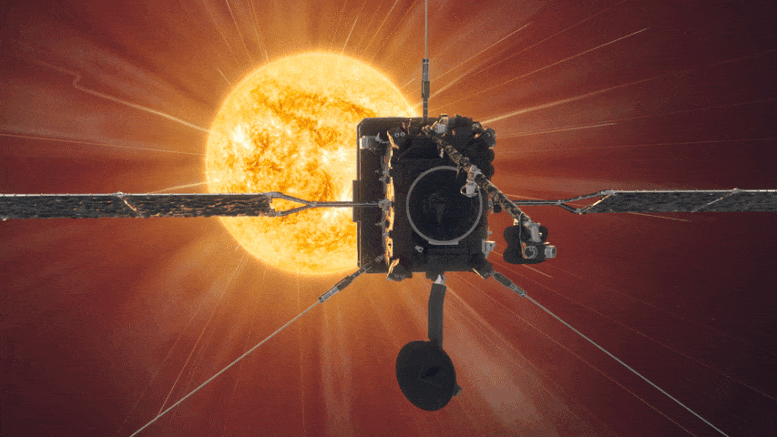

رسم متحرك لمستكشف الشمس “سولار أوربيتر” التابع لوكالة الفضاء الأوروبية. الائتمان: ESA / Medialab
تُظهر أحدث صور Solar Orbiter الشمس الكاملة بتفاصيل غير مسبوقة. تم التقاطها في 7 مارس 2022 ، عندما كانت المركبة الفضائية تعبر مباشرة بين الأرض والشمس.
إحدى الصور التي تم التقاطها بواسطة Extreme Ultraviolet Imager (EUI) هي الصورة الأعلى دقة لقرص الشمس الكامل والغلاف الجوي الخارجي ، الهالة ، تم التقاطها على الإطلاق.
صورة أخرى التقطتها أداة Spectral Imaging of the Coronal Environment (SPICE) تمثل أول صورة كاملة للشمس من نوعها منذ 50 عامًا ، وأفضل صورة التقطت على طول موجة ليمان بيتا من الأشعة فوق البنفسجية المنبعثة من غاز الهيدروجين.
تم التقاط الصور عندما كانت المركبة الشمسية المدارية على بعد 75 مليون كيلومتر تقريبًا ، في منتصف الطريق بين عالمنا ونجمه الأم. يلتقط التلسكوب عالي الدقة الخاص بـ EUI صورًا ذات دقة مكانية عالية بحيث يلزم ، عند تلك المسافة القريبة ، فسيفساء من 25 صورة فردية لتغطية الشمس بأكملها. تم التقاط الصورة الكاملة ، التي تم التقاطها واحدة تلو الأخرى ، على مدى أكثر من أربع ساعات لأن كل قطعة تستغرق حوالي 10 دقائق ، بما في ذلك الوقت الذي تستغرقه المركبة الفضائية للإشارة من جزء إلى آخر.

الشمس كما تراها Solar Orbiter في ضوء الأشعة فوق البنفسجية المتطرفة من مسافة 75 مليون كيلومتر تقريبًا. الصورة عبارة عن فسيفساء من 25 صورة فردية تم التقاطها في 7 مارس 2022 بواسطة التلسكوب عالي الدقة الخاص بأداة التصوير بالأشعة فوق البنفسجية (EUI). تم التقاط هذه الصورة بطول موجة 17 نانومتر ، في منطقة الأشعة فوق البنفسجية المتطرفة من الطيف الكهرومغناطيسي ، وتكشف الغلاف الجوي العلوي للشمس ، الهالة ، الذي تبلغ درجة حرارته حوالي مليون درجة مئوية. يتم أيضًا تضمين صورة الأرض للمقياس عند موضع الساعة 2. الائتمان: ESA و NASA / Solar Orbiter / فريق EUI ؛ معالجة البيانات: E. Kraaikamp (ROB)
في المجموع ، فإن الصورة النهائية يحتوي على أكثر من 83 مليون بكسل في شبكة 9148 × 9112 بكسل. للمقارنة ، هذه الصورة لديها دقة أفضل عشر مرات مما يمكن أن تعرضه شاشة تلفزيون 4K.
يصور EUI الشمس بطول موجة 17 نانومتر ، في منطقة الأشعة فوق البنفسجية المتطرفة من الطيف الكهرومغناطيسي. يكشف هذا الغلاف الجوي العلوي للشمس ، الهالة ، الذي تبلغ درجة حرارته حوالي مليون درجة[{” attribute=””>Celsius.

Solar Orbiter took images of the Sun on March 7, from a distance of roughly 75 million kilometres, using its Spectral Imaging of the Coronal Environment (SPICE) instrument. SPICE takes simultaneous “spectral images” at several different wavelengths of the extreme ultraviolet spectrum by scanning its spectrometer slit across a region on the Sun. The different wavelengths recorded correspond to different layers in the Sun’s lower atmosphere. Purple corresponds to hydrogen gas at a temperature of 10,000°C, blue to carbon at 32,000°C, green to oxygen at 320,000°C, yellow to neon at 630,000°C. Each full-Sun image is made up of a mosaic of 25 individual scans. It represents the best full Sun image taken at the Lyman beta wavelength of ultraviolet light that is emitted by hydrogen gas. Credit: ESA & NASA/Solar Orbiter/SPICE team; Data processing: G. Pelouze (IAS)
At the 2 o’clock (near the image of the Earth for scale) and 8 o’clock positions on the edges of the Sun, dark filaments can be seen projecting away from the surface. These ‘prominences’ are prone to erupt, throwing huge quantities of coronal gas into space and creating ‘space weather’ storms.
In addition to EUI, the SPICE instrument was also recording data during the crossing. These too needed to be pieced together as a mosaic.
SPICE is designed to trace the layers in the Sun’s atmosphere from the corona, down to a layer known as the chromosphere, getting closer to the surface. The instrument does this by looking at the different wavelengths of extreme ultraviolet light that come from different atoms.

Taking the Sun’s temperature. Credit: ESA & NASA/Solar Orbiter/SPICE team; Data processing: G. Pelouze (IAS)
In the SPICE sequence of images purple corresponds to hydrogen gas at a temperature of 10,000°C, blue to carbon at 32,000°C, green to oxygen at 320,000°C, yellow to neon at 630,000°C.
This will allow solar physicists to trace the extraordinarily powerful eruptions that take place in the corona down through the lower atmospheric layers. It will also allow them to study one of the most puzzling observations about the Sun: how the temperature is rising through the ascending atmospheric layers.
Usually the temperature drops as you move away from a hot object. But above the Sun, the corona reaches a million degrees Celsius whereas the surface is only about 5000°C. Investigating this mystery is one of the key scientific objectives of Solar Orbiter.
The images were taken on 7 March, precisely when Solar Orbiter crossed the Sun-Earth line, so the images can be compared with Earth-bound solar instruments and cross-calibrated. This will make it easier to compare results from different instruments and observatories in future.
On March 26, Solar Orbiter reaches another mission milestone: its first close perihelion. The spacecraft is now inside the orbit of Mercury, the inner planet, taking the highest resolution images of the Sun it can take. It is also recording data on the solar wind of particles that flows outwards from the Sun.
And this is just the start, over the coming years the spacecraft will repeatedly fly this close to the Sun. It will also gradually raise its orientation to view the Sun’s previously unobserved polar regions.
Solar Orbiter is a space mission of international collaboration between ESA and NASA.

“متعطش للطعام. طالب. متحمس محترف للزومبي. مبشر شغوف بالإنترنت.”






More Stories
صاروخ فالكون 9 التابع لشركة سبيس إكس يتوقف قبل إطلاقه ملياردير في مهمة خاصة
بقرة بحرية ما قبل التاريخ أكلها تمساح وسمكة قرش، بحسب حفريات
إدارة الطيران الفيدرالية تطلب التحقيق في فشل هبوط صاروخ فالكون 9 التابع لشركة سبيس إكس